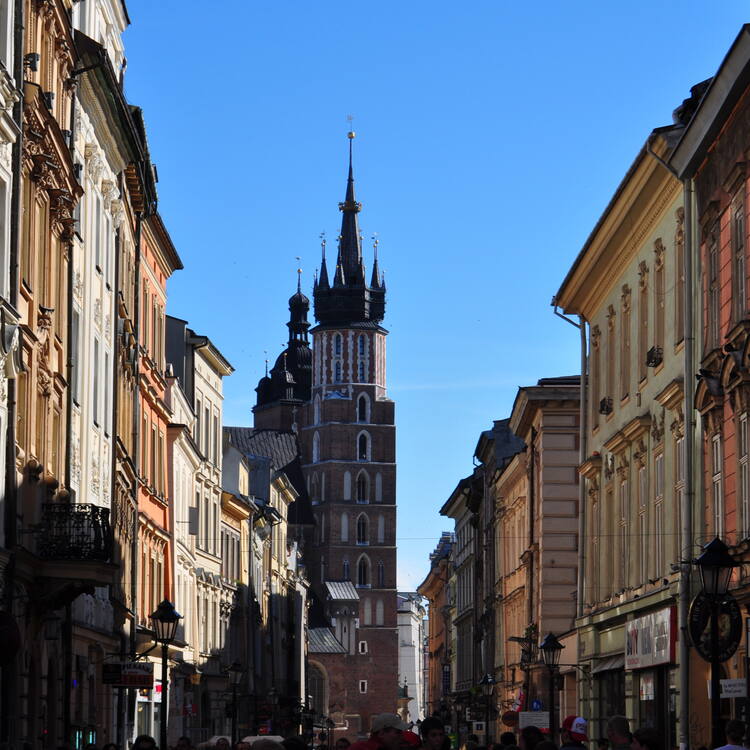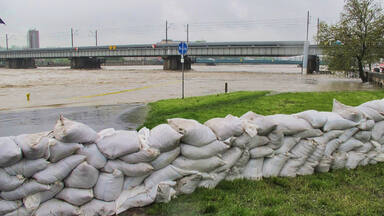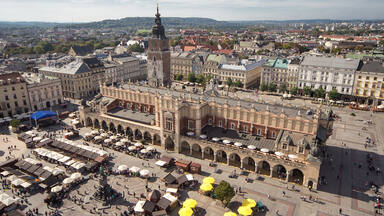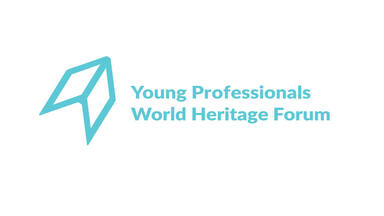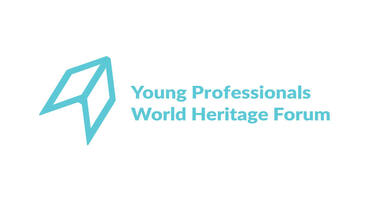Historic Centre of Kraków
Historic Centre of Kraków
The Historic Centre of Kraków, the former capital of Poland, is situated at the foot of the Royal Wawel Castle. The 13th-century merchants' town has Europe's largest market square and numerous historical houses, palaces and churches with their magnificent interiors. Further evidence of the town's fascinating history is provided by the remnants of the 14th-century fortifications and the medieval site of Kazimierz with its ancient synagogues in the southern part of town, Jagellonian University and the Gothic cathedral where the kings of Poland were buried.
Description is available under license CC-BY-SA IGO 3.0
Centre historique de Kraków
Le passionnant Centre historique de Kraków, ancienne capitale de la Pologne, est situé au pied du château royal de Wawel. Cette ville de marchands qui date du XIIIe siècle comprend la plus grande place de marché d'Europe, de nombreuses maisons historiques, ainsi que des palais et églises richement décorés. Des vestiges de remparts du XIVe siècle et le site médiéval de Kazimierz au sud de la ville, avec ses synagogues anciennes, l'Université Jagellon et la cathédrale gothique où sont enterrés les rois de Pologne, témoignent du riche passé de cette ville.
Description is available under license CC-BY-SA IGO 3.0
وسط كراكوفيا التاريخي
يقع الوسط التاريخي المدهش في كراكوفي، التي كانت عاصمة بولندا سابقًا، عند أقدام قلعة واويل الملكية. وتتضمّن مدينة البائعين المتجوّلين التي تعود الى القرن الثالث عشر، أكبر سوق في أوروبا وعددًا كبيرًا من البيوت الأثرية، بالاضافة الى القصور والكنائس المزخرفة. أما بقايا الأسوار التي تعود الى القرن الرابع عشر وموقع كازيمييرز جنوب المدينة والذي يعود الى القرون الوسطى، اضافة الى المعابد اليهوديّة القديمة، وجامعة جاغلّون والكاتدرائية القوطية حيث يدفن ملوك بولندا، فتشهد كلّها على ماضي هذه المدينة الحافل.
source: UNESCO/CPE
Description is available under license CC-BY-SA IGO 3.0
克拉科夫历史中心
克拉科夫历史名城,是波兰的前首都,坐落于华威尔皇家城堡的山脚下。这个13世纪的商业城镇拥有欧洲最大的露天市场和无数内部装潢华丽的历史建筑、宫殿及教堂。克拉科夫历史名城其他迷人的遗迹包括14世纪的要塞遗址,卡齐米日的中世纪遗址及其位于城南的古老犹太教堂、加杰劳尼大学和波兰国王的安息之地——哥特式大教堂。
source: UNESCO/CPE
Description is available under license CC-BY-SA IGO 3.0
Исторический центр Кракова
Исторический центр Кракова, в прошлом – столицы польского государства, расположен у подножья королевского замка Вавель. В этом купеческом городе XIII в. находятся самая большая в Европе рыночная площадь и множество исторических жилых домов, дворцов и церквей с великолепными интерьерами. Дополнительным свидетельством интересной истории города являются остатки укреплений XIV в., средневековое поселение Казимеж с древними синагогами в южной части города, Ягеллонский университет и готический кафедральный собор с усыпальницей польских королей.
source: UNESCO/CPE
Description is available under license CC-BY-SA IGO 3.0
Centro histórico de Cracovia
El centro histórico de Cracovia, antigua capital de Polonia, se extiende al pie del castillo real de Wawel. Además del núcleo de la ciudad mercantil del siglo XIII, con la plaza del mercado más grande de Europa y sus numerosas mansiones históricas, iglesias y palacios magníficamente ornamentados en su interior, el sitio comprende otros testimonios del fascinante pasado histórico de Cracovia como los vestigios de las murallas del siglo XIV, el sitio medieval de Kazimierz –situado al sur de la ciudad– con sus antiguas sinagogas, la Universidad Jagellona y la catedral gótica, panteón de los reyes de Polonia.
source: UNESCO/CPE
Description is available under license CC-BY-SA IGO 3.0
クラクフ歴史地区
ポーランド南部の古都。1320年に首都となり、ヤゲロ朝(1386~1572)時代に最盛期を迎え、プラハ、ウィーンと並ぶ中欧の文化、芸術、経済の中心地となった。第二次世界大戦の戦火を奇跡的に免れ、幾多の歴史的・文化的建造物が残されている。中でも14世紀の織物会館、塔のみ残る旧市庁舎、ポーランド最古の大学ヤゲロ大学、ゴシック様式の聖マリア教会、歴代ポーランド王の居城ヴァヴェル城などが知られている。source: NFUAJ
Historisch centrum van Krakau
Krakau is de voormalige hoofdstad van Polen. Het historisch centrum ligt aan de voet van het Koninklijke Wawel kasteel. De 13e-eeuwse handelsstad heeft het grootste marktplein van Europa en talrijke historische huizen, paleizen en kerken met prachtige interieurs. De fascinerende geschiedenis van deze stad is ook terug te vinden in de resten van de 14e-eeuwse vestingwerken en de middeleeuwse wijk Kazimierz, met zijn oude synagogen in het zuidelijk deel van de stad. Andere getuigen van Krakaus rijke historie zijn de universiteit van Jagiellonia en de gotische kathedraal, waar de koningen van Polen werden begraven.
Source: unesco.nl
Outstanding Universal Value
Brief synthesis
The Historic Centre of Kraków, located on the River Vistula in southern Poland, is formed by three urban ensembles: the medieval chartered City of Kraków, the Wawel Hill complex, and the town of Kazimierz (including the suburb of Stradom). It is one of the most outstanding examples of European urban planning, characterised by the harmonious development and accumulation of features representing all architectural styles from the early Romanesque to the Modernist periods.
The importance of the city, which was chartered in 1257 and was once the capital of Poland, is evidenced by its urban layout, its numerous churches and monasteries, its imposing public buildings, the remains of its medieval city walls, and its palaces and townhouses, many designed and built by prominent architects and craftspersons. The value of this urban complex is determined by the extraordinary density of monuments from various periods, preserved in their original forms and with their authentic fittings. Wawel Hill, the dominant feature of the Historic Centre of Kraków, is a former royal residence and necropolis attesting to the dynastic and political links of medieval and early modern Europe. The medieval town of Kazimierz, which includes the suburb of Stradom (chartered in 1335), was shaped by the Catholic and Jewish faiths and their respective cultures and customs.
One of the largest administrative and commercial centres in central Europe, Kraków was a city where arts and crafts flourished, and the culture of East and West intermingled. The importance of Kraków as a cultural centre of European significance is reinforced by its being home to one of the oldest universities of international renown – the Jagiellonian University. Together, these three built-up areas create a cohesive urban complex in which significant tangible and intangible heritage have survived and are cultivated to this day.
Criterion (iv): Kraków is an urban architectural ensemble of outstanding quality, in terms of both its townscape and its individual monuments. The historic centre of the town admirably illustrates the process of continuous urban growth from the Middle Ages to the present day.
Integrity
The Historic Centre of Kraków retains a high level of integrity. The property has clearly defined, historically stable boundaries that encompass all the elements that express its Outstanding Universal Value, which remain intact and in good condition. The most important of these elements include Wawel Hill with its castle and cathedral, which symbolize the city’s history as a seat of royal and Episcopal power; and the medieval urban layout and historic fabric of two initially separate towns – Kraków and Kazimierz. Moreover, the multiple styles and cultures evident in Kraków and Kazimierz demonstrate the diversity of influences which had an impact on Kraków’s development as an urban complex, and which reflect the roles played in this process by different nations. The property is thus of adequate size to ensure the complete representation of the features and processes that convey its significance, and it does not suffer from adverse effects of development and/or neglect.
Authenticity
The Historic Centre of Kraków is imbued with a pervading authenticity that is manifested in its location and setting, its forms and designs, its materials and substance, and, to a degree, its uses and functions. The topography of the property and the relationship between the River Vistula and the local hills and rock outcrops, best illustrated by the Wawel Hill complex, remain legible. Due to the towns’ medieval charters based on Magdeburg law, which entailed bringing order to the urban layout, the urban clarity and functionality of both Kraków and Kazimierz survive to this day: the few later alterations to settlement plots did not give rise to any changes in the street network. The city’s panorama also remains intact, complete with its distinctive historic landmarks, such as Wawel Hill, the Town Hall Tower, and the individual churches. Contemporary features in the city’s vistas are minor, and are located at some distance from the historic centre. In addition, many buildings and facilities have remained in use for their intended purposes for generations.
The predominantly composite architectural structures represent multiple phases of development and incorporate components from various periods. Modern-day interventions represent a continuation of this historical process. When introduced with respect for the scale and outline of the existing built environment, they do not undermine the ensemble’s authenticity. The property’s rich historic architectural detail (both buildings and urban public spaces) requires rigorous protection and a conscious conservation policy.
Protection and management requirements
The Historic Centre of Kraków, which is under a mixture of public and private ownership, is protected in its entirety by the law. The built environment of Wawel Hill and the urban layouts of the medieval towns of Kraków and Kazimierz (including the Stradom suburb) are inscribed in the National Heritage Register. A substantial majority of the buildings located within the boundaries of the 149.65 ha property also feature individually in the National Heritage Register. The property has been awarded Monument of History status by the President of the Republic of Poland, thus affording it an additional form of protection. This, in effect, has provided a coherent system of legal protection for all of the parts of the property. Since 2010, the Historic Centre of Kraków has also had a 907.35 ha buffer zone to assist in the property’s protection, conservation, and management.
Provisions to protect historic monuments have been introduced to the city’s strategic policy documents. A communal monument preservation programme encompassing the entire city defines the conditions for managing the World Heritage property. Local land development plans being prepared for the property and buffer zone will address protection issues by providing the possibility of managing the transformation of the city’s landscape, public spaces, and small-scale architectural details. Furthermore, a “cultural park” preservation plan for the Old Town specifies thematic areas to be monitored and controlled. The Historic Centre of Kraków is under self-government administration and is managed by its President and City Council. Matters concerning monument protection are handled by a special organizational unit in the Town Hall and by state monument protection authorities at the regional level. The law enables relevant conservation authorities to supervise and intervene in any activities that could potentially result in alterations to the urban layout or to individual buildings within the confines of the property.
In order to ensure efficient and long-term conservation of the property, it will be necessary to strengthen the integration of conservation activities with the general management of the entire municipal area, including the zoning policy, social policy, and sustainable tourism. The regulation of spatial management conditions, as well as the introduction of protection provisions for the World Heritage property and its surroundings in all planning documents, represent an element of the city’s long-term land development planning policy. Regular conservation and continuous monitoring of the condition of individual elements of the urban layout and their mutual relationships in the property and buffer zone represent important elements of conservation and management efforts. To preserve the character of the property, which exhibits centuries of historic and cultural overlaps, the development process should be continued in a permanent and balanced way, corresponding to its existing architectural, urban, and social contexts. The implementation of these goals and task shall serve in the preparation of a Management Plan for the property. This Management Plan, as the integrating document, will enable the coordination of activities within the area of the World Heritage property and its buffer zone.
Links
-
The Wawel Royal Castle Museum
-
City of Kraków YouTube account (in Polish only)
-
Kraków Experience Facebook page (in Polish only)
-
Kraków Twitter (X) page (in Polish only)
-
Kraków Travel - Guide
-
Museum of Kraków
-
Społeczny Komitet Odnowy Zabytków Krakowa (only in Polish)
-
Kraków Official Website
-
International Cultural Centre (Miêdzynarodowe)
